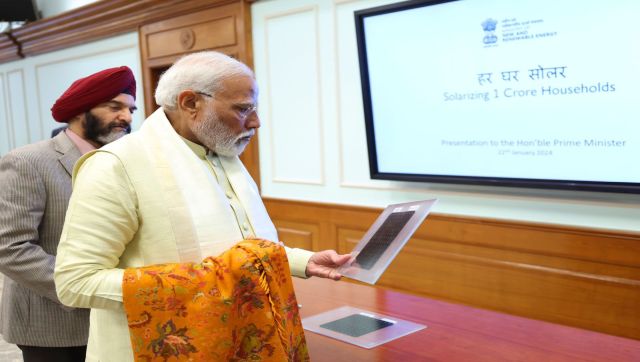Monday (22 January) was a big, big day for Prime Minister Narendra Modi. He presided over the consecration ceremony, also known as the pran pratishtha, of the Ram mandir in Ayodhya during the day and then later announced a huge scheme for people.
In a post on X, PM Modi on Monday evening wrote, “The first decision I have taken after returning from Ayodhya is that our government will launch ‘Pradhanmantri Suryodaya Yojana’ with the target of installing rooftop solar on one crore houses.”
He further added that the scheme was inspired by Lord Ram and that this scheme would not only help people, but also make the nation self-reliant in energy production.
Here’s what we know about the Pradhanmantri Suryodaya Yojana and how it will benefit India.
About the Pradhanmantri Suryodaya Yojana
On Monday, upon his arrival from Ayodhya where he presided over the consecration ceremony, Prime Minister Narendra Modi announced the scheme, called the Pradhanmantri Suryodaya Yojana, under which one crore households will get solar rooftops.
In a post on X, Modi said: “Today, on the auspicious occasion of the consecration of life in Ayodhya, my resolve has been further strengthened that the people of India should have their own solar rooftop system on the roof of their houses. The first decision I have taken after returning from Ayodhya is that our government will launch ‘Pradhanmantri Suryodaya Yojana’ with the target of installing rooftop solar on 1 crore houses.”
He added that the scheme would help not only reduce electricity bills of the “poor and middle class”, but also push India’s goal of becoming self-reliant in the energy sector.
The scheme aims to provide electricity to low and middle-income individuals through solar rooftop installations. Moreover, it will offer additional income for surplus electricity generation.
Similar to previous scheme
Notably, the Pradhanmantri Suryodaya Yojana is very similar to the previously announced Rooftop Solar Programme in 2014. The previous scheme had aimed to produce 40,000 megawatts (MW) or 40 gigawatts (GW) of solar power by 2022.
In 2022, this programmed received a four-year extension and now aims at achieving its target of 4,000 megawatt (40 gigawatt) rooftop solar capacity addition, by March 2026. In fact, the Ministry of New and Renewable Energy had then said that the Rooftop Solar Programme Phase-II has been extended until 31 March 2026, without any financial implication, — within the originally approved total outlay of Rs 118.14 billion for both components of the programme – the incentives to distribution companies and Central Financial Assistance to the residential sector.
Also read: What is India’s ambitious ‘OSOWOG’ global solar grid proposal?
And how did this scheme work? Minister of New and Renewable Energy RK Singh had previously said that the consumer can choose any vendor on the national portal and after installation, the subsidy is sent directly to the bank account of the consumer.
India harnessing the sun’s power
At the end of last year, 2023, India’s solar power generation stood at 73.31 GW, up from 2022’s 63.3 GW. However, rooftop solar power generation only stands at around 11.08 GW as of December 2023. Data reveals that of the total solar power generated in the nation, Rajasthan leads the pack with 18.7 GW while Gujarat follows with 10.5 GW. However, when talking about rooftop solar power, Gujarat is at peak position — with 2.8 GW — followed by Maharashtra at 1.7 GW.
According to a report by JMK Research & Analysis and Institute for Energy Economics and Financial Analysis, India having more than 300 million households and an average of 300 sunny days each year, has tremendous potential for rooftop solar installations in residential spaces.
And keeping this in mind, the government has come out with different schemes and initiatives. However, experts note that despite several measures, India’s rooftop solar power generation is not where it should be, listing reasons for the situation.
Senior Programme Lead from Council on Energy, Environment and Water, Neeraj Kuldeep, speaking to Mongabay, said that the primary reasons for rooftop solar not becoming popular is that it is still an expensive option for many. Interestingly, a report revealed that in 2020, the average cost of a residential rooftop solar system in India was $658 per kilowatt. If compared with other leading rooftop solar residential markets like Japan, the United Kingdom, Switzerland, and the United States of America, it is three to six times cheaper. But people still find it exorbitant.
Kuldeep further explained that there is also a lack of awareness. Moreover, consumers receive subsidised electricity from electricity distribution companies.
Importance of solar power to India
Harnessing the power of the sun to generate electricity is important to India for multiple reasons. If India wants to achieve its aim of becoming net zero by 2070, it has to look towards the sun. In fact, at COP26, in November 2021, India had committed to meet 50 per cent of its electricity requirements from renewable energy sources by 2030. For these aims to be met, India has to harness the full capacity of the sun.
Moreover, India’s share of global energy demand is predicted to double to 11 per cent in 2040, making it imperative to enhance energy security and self-sufficiency in power generation without increasing environmental costs. This increase in power demand is likely to increase India’s reliance on coal, oil and natural gas as a source of energy.
However, additional imports of oil and increased domestic production of coal will not only fall short of energy demand but will also entail economic and environmental costs. Expansion of solar power units and increased reliance on solar power allows India to enhance energy security in the face of rising demand.
Furthermore, India is already facing depleting groundwater levels, owing to which the nation must shift its energy resources away from water.
It is left to be seen if PM Modi’s new scheme is a step forward in this goal.
With inputs from agencies
Link to article –
PM Modi announces new rooftop solar power scheme: How this will help India go green





